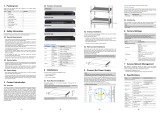Allied Telesis AT-X510DP-52GTX-NCB5 Datasheet
- Category
- Network switches
- Type
- Datasheet
This manual is also suitable for
Allied Telesis AT-X510DP-52GTX-NCB5 is a high-performing and feature-rich Gigabit Layer 3 switch, offering a versatile solution for enterprise applications. With 48 Gigabit ports and 4 SFP+ ports, it provides ample connectivity for various devices. The switch supports advanced features like Virtual Chassis Stacking (VCStack), allowing you to connect multiple units for enhanced resiliency and simplified management. It also supports Energy Efficient Ethernet (EEE) to reduce power consumption during periods of low traffic.
Allied Telesis AT-X510DP-52GTX-NCB5 is a high-performing and feature-rich Gigabit Layer 3 switch, offering a versatile solution for enterprise applications. With 48 Gigabit ports and 4 SFP+ ports, it provides ample connectivity for various devices. The switch supports advanced features like Virtual Chassis Stacking (VCStack), allowing you to connect multiple units for enhanced resiliency and simplified management. It also supports Energy Efficient Ethernet (EEE) to reduce power consumption during periods of low traffic.








-
 1
1
-
 2
2
-
 3
3
-
 4
4
-
 5
5
-
 6
6
-
 7
7
-
 8
8
Allied Telesis AT-X510DP-52GTX-NCB5 Datasheet
- Category
- Network switches
- Type
- Datasheet
- This manual is also suitable for
Allied Telesis AT-X510DP-52GTX-NCB5 is a high-performing and feature-rich Gigabit Layer 3 switch, offering a versatile solution for enterprise applications. With 48 Gigabit ports and 4 SFP+ ports, it provides ample connectivity for various devices. The switch supports advanced features like Virtual Chassis Stacking (VCStack), allowing you to connect multiple units for enhanced resiliency and simplified management. It also supports Energy Efficient Ethernet (EEE) to reduce power consumption during periods of low traffic.
Ask a question and I''ll find the answer in the document
Finding information in a document is now easier with AI
Related papers
-
Allied Telesis 990-004272-50 Datasheet
-
Allied Telesis 990-001206-00 Datasheet
-
Allied Telesis AT-x510-28GTX Datasheet
-
Allied Telesis Switch IPV6 User manual
-
Allied Telesis SwitchBlade x908 Solution Guide
-
Allied Telesis Sector Antenna User manual
-
Allied Telesis 1000LX SFP 40 Km (1550nm) Datasheet
-
Allied Telesis AT-IX5-28GPX Datasheet
-
Allied Telesis AT-TQ0292 Datasheet
-
Allied Telesis 990-00160-00 Datasheet
Other documents
-
Repotec RP-IPG512-4F Owner's manual
-
Enterasys KG2001-0224 Datasheet
-
Ruby Tech PSGS-2112C User manual
-
 EtherWAN EG97244 Series User manual
EtherWAN EG97244 Series User manual
-
Avaya AL1905B3F-E6 Datasheet
-
D-Link DGS-1510-28 Datasheet
-
Interlogix Industrial Gigabit Managed Switches (NS3553-4P-1T-2S) User manual
-
Longshine LCS-C862 User manual
-
Avaya AL4800B78-E6 User manual
-
 UTEPO UTP5652S Series Quick Installation Guide
UTEPO UTP5652S Series Quick Installation Guide









